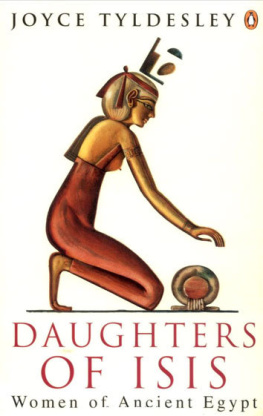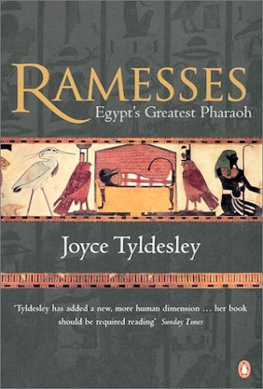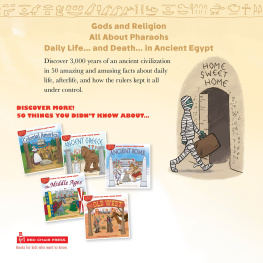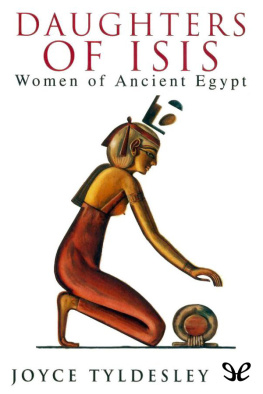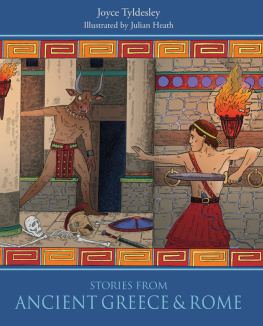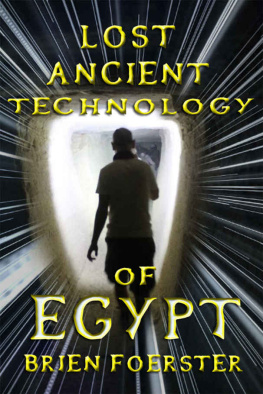Joyce A. Tyldesley - Daughters of Isis: Women of Ancient Egypt
Here you can read online Joyce A. Tyldesley - Daughters of Isis: Women of Ancient Egypt full text of the book (entire story) in english for free. Download pdf and epub, get meaning, cover and reviews about this ebook. year: 1995, publisher: Penguin Books, genre: Romance novel. Description of the work, (preface) as well as reviews are available. Best literature library LitArk.com created for fans of good reading and offers a wide selection of genres:
Romance novel
Science fiction
Adventure
Detective
Science
History
Home and family
Prose
Art
Politics
Computer
Non-fiction
Religion
Business
Children
Humor
Choose a favorite category and find really read worthwhile books. Enjoy immersion in the world of imagination, feel the emotions of the characters or learn something new for yourself, make an fascinating discovery.
- Book:Daughters of Isis: Women of Ancient Egypt
- Author:
- Publisher:Penguin Books
- Genre:
- Year:1995
- Rating:3 / 5
- Favourites:Add to favourites
- Your mark:
- 60
- 1
- 2
- 3
- 4
- 5
Daughters of Isis: Women of Ancient Egypt: summary, description and annotation
We offer to read an annotation, description, summary or preface (depends on what the author of the book "Daughters of Isis: Women of Ancient Egypt" wrote himself). If you haven't found the necessary information about the book — write in the comments, we will try to find it.
Daughters of Isis: Women of Ancient Egypt — read online for free the complete book (whole text) full work
Below is the text of the book, divided by pages. System saving the place of the last page read, allows you to conveniently read the book "Daughters of Isis: Women of Ancient Egypt" online for free, without having to search again every time where you left off. Put a bookmark, and you can go to the page where you finished reading at any time.
Font size:
Interval:
Bookmark:
PENGUIN BOOKS
DAUGHTERS OF ISIS
Joyce Ann Tyldesley was born in Bolton, Lancashire. She gained a first-class honours degree in archaeology from Liverpool University in 1981 and a doctorate from Oxford University in 1986. She is now Honorary Research Fellow at the School of Archaeology, Classics and Oriental Studies at Liverpool University, and a freelance writer and lecturer on Egyptian archaeology. Her other books, which are also published in Penguin, are Hatchepsut: The Female Pharaoh, Nefertiti and Ramesses: Egypts Greatest Pharaoh.
WOMEN OF ANCIENT EGYPT

JOYCE TYLDESLEY

PENGUIN BOOKS
PENGUIN BOOKS
Published by the Penguin Group
Penguin Books Ltd, 80 Strand, London WC2R 0RL, England
Penguin Putnam Inc., 375 Hudson Street, New York, New York 10014, USA
Penguin Books Australia Ltd, 250 Camberwell Road, Camberwell, Victoria 3124, Australia
Penguin Books Canada Ltd, 10 Alcorn Avenue, Toronto, Ontario, Canada M4V 3B2
Penguin Books India (P) Ltd, 11 Community Centre, Panchsheel Park, New Delhi 110 017, India
Penguin Books (NZ) Ltd, Cnr Rosedale and Airborne Roads, Albany, Auckland, New Zealand
Penguin Books (South Africa) (Pty) Ltd, 24 Sturdee Avenue, Rosebank 2196, South Africa
Penguin Books Ltd, Registered Offices: 80 Strand, London WC2R 0RL, England
www.penguin.com
First published by Viking 1994
Published in Penguin Books 1995
Copyright J. A. Tyldesley, 1994
All rights reserved
The moral right of the author has been asserted
Except in the United States of America, this book is sold subject to the condition that it shall not, by way of trade or otherwise, be lent re-sold, hired out, or otherwise circulated without the publishers prior consent in any form of binding or cover other than that in which it is published and without a similar condition including this condition being imposed on the subsequent purchaser
ISBN: 978-0-14-194981-9
For Steven and Philippa Anne Snape
Objects recovered from Professor John Garstangs Beni Hassan and Abydos excavations are here illustrated by the original excavation photographs of 1904 and 19079. Thanks are due to Professor Slater of Liverpool University for permission to reproduce these hitherto unpublished photographs.
I would like to express my gratitude to all those whose contribution has made this book possible. Paul Bahn, Eleo Gordon and Sheila Watson gave me both encouragement and practical advice whenever necessary. Angela Thomas and the staff of the Bolton Museum cheerfully provided photographic prints, while the members of the Liverpool University S.E.S. photography department, Ian Qualtrough and Suzanne Yee, were unfailingly helpful at all times. Thanks are due to Professor Elizabeth Slater of Liverpool University for permission to photograph some of the previously unpublished objects in the University archaeological collection. Above all, Steven Snape has been a remarkably patient husband, never doubting that this book, started in 1986, would eventually be finished.
Where possible, this book has included quotations from contemporary documents which give the Egyptians the opportunity to speak for themselves. Those familiar with published Egyptian literature will immediately recognize the immense debt owed to the translation work of Miriam Lichtheim, which has been used as the basis of many of the quotations given.
The line drawings included in the text have been redrawn by the author from published sources; full acknowledgement of the sources of these drawings is provided in the list of illustrations given on .

Not only is the Egyptian climate peculiar to that country and the Nile different in behaviour to other rivers, but the Egyptians themselves, in most of their manners and customs, exactly reverse the common practices of mankind. For example, the women attend the markets and trade, while the men sit at home and weave at the loom The women likewise carry burdens upon their shoulders while the men carry them upon their heads Sons need not support their parents unless they chose, but daughters must, whether they chose to or not.
Herodotus tells of the wonders of Egypt
When the Greek historian Herodotus visited Egypt at the very end of the dynastic period, he was struck by the topsy-turvy nature of both the land and its people. There was no question about it, Egypt was a very peculiar country. The climate could only be described as unusual, the River Nile behaved like no other river in the classical world, and the relations between the sexes were simply extraordinary. Herodotus had never before encountered women who appeared to be as free as their menfolk, and he was intrigued by their behaviour. As he travelled around the country he made detailed notes of all that he observed, taking every opportunity to participate in local customs and chatting to the locals wherever possible. On his return to Greece he recorded his experiences in a combined travel-guide and history of Egypt; the first book to introduce the exotic and mysterious land of the pharaohs to European readers.
Herodotus was quite correct to single out the long thin geography of Egypt as a crucial factor in the development of her people. The River Nile, flowing north through a narrow strip of cultivated land to branch into the separate streams of the Delta, dominated every aspect of Dynastic life, and it would be impossible to gain any insight into the thoughts and deeds of the ancient Egyptians without an understanding of the land in which they lived. As Herodotus himself remarked, in an often-repeated phrase, Egypt is the gift of the Nile.
Egypt is an African Mediterranean country with close geographical links with Palestine and the Near East. The first cataract of the Nile, just to the south of the modern town of Aswan, marks the traditional southern boundary of Egypt, although at times of imperial expansion this border was pushed further south into Nubia. Conventionally, this southern region is known as Upper Egypt while the northern area including the Nile Delta is known as Lower Egypt. To the north, Egypt is bounded by the Mediterranean Sea. During the Dynastic period the narrowness of the fertile land effectively restricted expansion to the east and west of the Nile, though the deserts were exploited for natural resources as and when required. Egypt maintained fluctuating economic ties with her immediate neighbours Nubia to the south and Syria and Palestine to the east while contact with the more distant lands of Mesopotamia, Anatolia and Crete led to Mediterranean and Near Eastern influences being absorbed into Egyptian society. However, thanks to her abundant natural resources and her geographical near-isolation, Egypt was able to remain a basically independent and self-sufficient country throughout her long history.
The Egyptians themselves knew their country as the Black Land, referring to the all-important ribbon of highly fertile soil which lined the banks of the Nile. The cultivated Black Land was in turn enclosed by the Red Land, the barren desert and cliffs which were only suitable for the construction of burial grounds and royal tombs. The difference between the fertile Black Land and the infertile Red Land has always been both clear and extreme, and many visitors to Egypt have noted how it is literally possible to stand with one foot in the desert sand and one foot on the green cultivation. This perpetual reminder of the stark contrast between the living and the dead, the fertile and the infertile, left an indelible mark on secular and religious thought, and the constant cycle of birth, death and rebirth became an endlessly repeated theme of Egyptian life.
Font size:
Interval:
Bookmark:
Similar books «Daughters of Isis: Women of Ancient Egypt»
Look at similar books to Daughters of Isis: Women of Ancient Egypt. We have selected literature similar in name and meaning in the hope of providing readers with more options to find new, interesting, not yet read works.
Discussion, reviews of the book Daughters of Isis: Women of Ancient Egypt and just readers' own opinions. Leave your comments, write what you think about the work, its meaning or the main characters. Specify what exactly you liked and what you didn't like, and why you think so.

